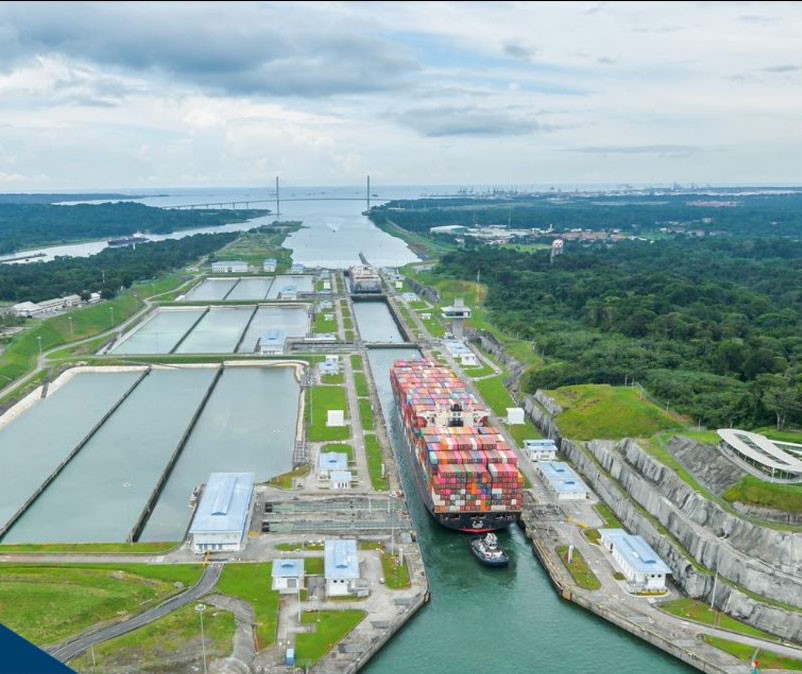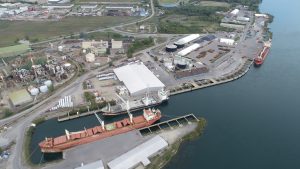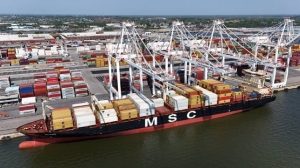The Panama Canal closed its fiscal year 2021 (FY21) with a record-breaking annual tonnage of 516.7 million Panama Canal tons (PC/UMS), coming in 8.7% higher compared to the 2020 fiscal year (FY20) and 10% above tonnage registered in FY19, the waterway’s last pre-pandemic fiscal year.
“I am grateful for and proud of our world-class workforce, whose resilience and dedication allowed us, throughout the pandemic, to continue providing a service of excellence and enabling the uninterrupted delivery of essential goods around the world,” said Panama Canal Administrator Ricaurte Vásquez Morales. “This commitment was key in our ability to manage a record tonnage, which reinforces the Expanded Canal’s value to global trade after five years of successful operations.”
Fiscal year 2021 was marked by unprecedented supply chain challenges caused by the continued impact of the COVID-19 pandemic. Related disruptions drove container rates to rise exponentially and production to slow down across various sectors, due to raw material shortages. Amid this landscape, the Panama Canal saw traffic grow between October 1, 2020 and September 30, 2021, driven by liquefied natural gas (LNG), liquefied petroleum gas (LPG), containerships, dry bulkers, and vehicle carriers.
Containerships continue to reflect a surge in demand for finished consumer products, as increased purchases during the pandemic stressed supply chains and caused congestion in ports worldwide. Containerships registered 184.3 million PC/UMS tons through the Panama Canal this year, a 2% increase from tonnage compared to FY20, followed by dry bulk (90 million PC/UMS tons), chemical carriers (65 million PC/UMS tons), LNG (61 million PC/UMS tons) and LPG (52.8 million PC/UMS tons).
LNG carriers registered a 31.4% increase in tonnage through the Panama Canal, representing the largest gain across all segments. LNG also set new annual records for total tonnage and transits, in addition to monthly tonnage and transit records in January 2021, fueled by record winter temperatures in Asia. More LNG terminals located in in the Gulf Coast and the East Coast of the U.S. expanded their operations, spurring an increase in exports shipped to Asia.
“LNG is not only growing the fastest, but it has had its best year in terms of tonnage through the Canal,” said Ilya Espino de Marotta, Deputy Administrator of the Panama Canal. “However, this year’s figures across segments demonstrate the Canal can adapt and meet fluctuating market needs, as shown earlier this year, when we modified the Panama Canal reservation system to offer our customers additional booking options and flexibility.”
Containerships continue to reflect a surge in demand for finished consumer products, as increased purchases during the pandemic stressed supply chains and caused congestion in ports worldwide. Containerships registered 184.3 million PC/UMS tons through the Panama Canal this year, a 2% increase from tonnage compared to FY20, followed by dry bulk (90 million PC/UMS tons), chemical carriers (65 million PC/UMS tons), LNG (61 million PC/UMS tons) and LPG (52.8 million PC/UMS tons).
LNG carriers registered a 31.4% increase in tonnage through the Panama Canal, representing the largest gain across all segments. LNG also set new annual records for total tonnage and transits, in addition to monthly tonnage and transit records in January 2021, fueled by record winter temperatures in Asia. More LNG terminals located in in the Gulf Coast and the East Coast of the U.S. expanded their operations, spurring an increase in exports shipped to Asia.
“LNG is not only growing the fastest, but it has had its best year in terms of tonnage through the Canal,” said Ilya Espino de Marotta, Deputy Administrator of the Panama Canal. “However, this year’s figures across segments demonstrate the Canal can adapt and meet fluctuating market needs, as shown earlier this year, when we modified the Panama Canal reservation system to offer our customers additional booking options and flexibility.” (Photo Panama Canal Authority)





